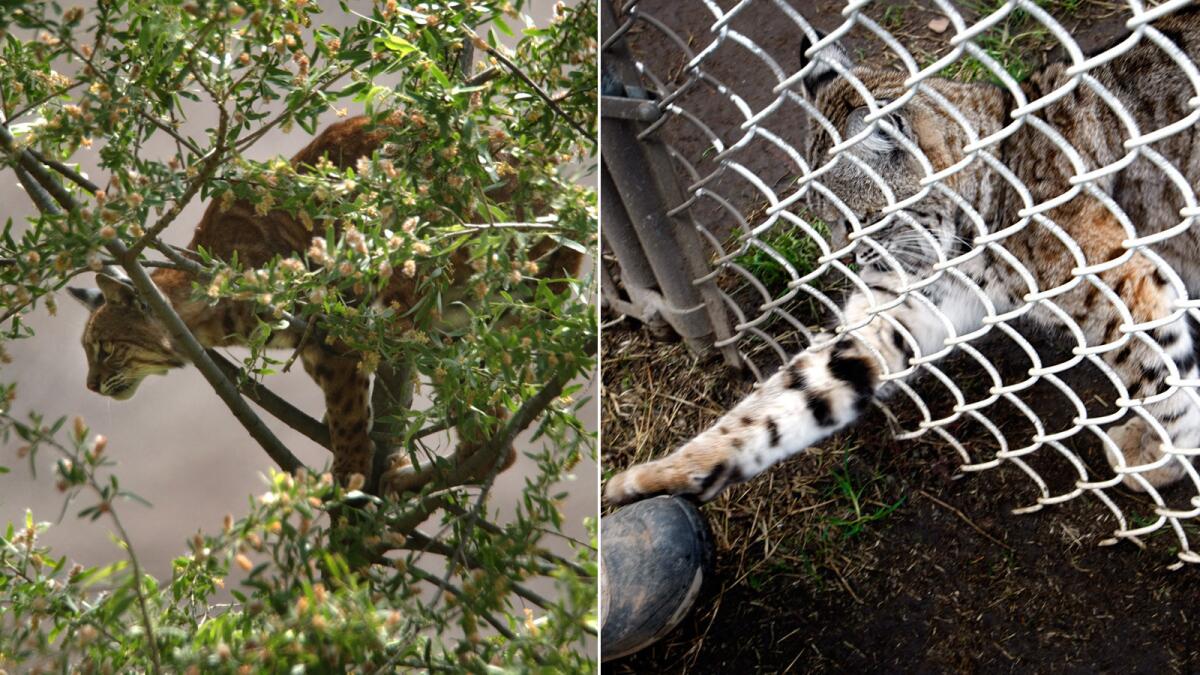California bans trapping of bobcats amid protests over cruelty

A treed bobcat in an Orange County Park, and one at a rescue facility.
The California Fish and Game Commission voted Wednesday to ban all commercial bobcat trapping in the state, even as members acknowledged they had no evidence the centuries-old industry was harming the species.
The commission voted 3 to 2 to eliminate the industry, with the majority citing two reasons.
The estimated 100 commercial bobcat trappers still working in the state, down from more than 3,000 three decades ago, cannot afford to pay the full cost of regulating their industry as required under the Bobcat Protection Act of 2013, commissioners said.
They also said they could not determine whether trapping jeopardized the species because they had no current scientific data on the health of the state bobcat populations.
“Before we make a decision to allow destruction of a natural resource, we should have the science to support that as a practice,” said Commissioner Anthony Williams, 47, of Huntington Beach, a newly appointed member and former director of government relations at Boeing Co. “I don’t think that burden has been met.”
The director of the state Department of Fish and Wildlife, Chuck Bonham, took issue with that logic, as did the California Trappers Assn.
“Bobcats are the most widespread and adaptive carnivores in the state next to coyotes,” Bonham told the commission before the vote. “There is no evidence that a ban on bobcat trapping is needed to protect bobcat populations.”
Hector Barajas, a spokesman for the trappers association, noted in an interview that when Gov. Jerry Brown signed the bobcat law, “he wanted the commission to develop the science to implement it properly. Two and a half years later, they still haven’t done that.”
Despite the governor’s comments, the commission never arranged for scientific research to update information from the last bobcat population survey, conducted in 1979. Commissioners said Wednesday they would be willing to consider allowing trapping to resume in certain areas if information is developed on the status of the species.
The vote does not affect any other forms of commercial trapping, because the state law grew out of outrage over incidents involving only bobcats near the edge of Joshua Tree National Park.
Landowners found bobcat traps set illegally on their property. Their complaints put a spotlight on the practice of trapping, killing and skinning native cats to supply fur markets in China, Russia and Greece, even as other furred animals continue to be trapped commercially in the state.
Under state regulations, trappers must pay $113.75 and pass a test for a license to trap fur-bearing game animals — pine marten, fisher, mink, river otter, gray fox, red fox, kit fox, raccoon, beaver, badger and muskrat — as well as non-game animals including bobcats.
Before approving a statewide ban, the commission rejected a proposal that would have banned trapping around federal and state parks and other protected lands. It would have allowed trapping in designated zones covering about 40% of the state, including much of Southern California. It also would have required trappers to pay an annual validation fee of $1,325 in addition to a $35 shipping tag fee per animal.
But a majority of the commission doubted there were enough bobcat trappers left in the state to cover the costs of regulating their harvests. Estimated costs of administering and enforcing trapping programs across the state range from $212,000 to more than $600,000.
“The 3-2 vote was recognition that the statewide ban was ultimately the most effective way to implement the policy the law represented,” said Assemblyman Richard Hershel Bloom (D-Santa Monica), author of the bobcat act and one of more than 100 public speakers at the commission hearing in Fortuna, Calif.
“It also demonstrated a growing awareness about how we treat native wildlife in California,” Bloom said. “There’s a big difference, for example, between hunting a game animal and taking home to eat it, and trapping an animal for commercial purposes and doing it in a way that causes a long painful death.”
To date, there have been more than 25,000 registered comments in support of the statewide ban, and a dozen letters in favor of trapping zones.
The ban eliminated a livelihood and vestige of California heritage: trapping predatory carnivores whose pelts fetch about $350 each in foreign fur markets. Wildlife advocates decry it as a cruel trade and anachronism.
“Today, California stepped into the 21st century of wildlife management,” said Brendan Cummings, senior counsel for the Center for Biological Diversity. “We place a higher value on native wildlife alive, rather than as dead commodities.”
Barajas of the trappers association said commissioners destroyed an industry without reasonable cause. “The commission has become a political arm of the animal rights extremists,” he said.
Mercer Lawing, director of the association and owner of a company that manufactures bobcat traps in Barstow, said in an interview that wildlife advocates are “very passionate about their precious little bobcats.”
“We love those animals and know more about them than those people do,” Lawing said. “If they ever get bobcat trapping banned, they’ll have bobcats running through their neighborhoods, eating their dogs and kittens.”
ALSO:
Meet L.A.’s newest mountain lion kittens (they’re cute too)
Shirtless man climbs Santa Ana zoo monkey exhibit, screams ‘I am Tarzan!’
Idaho’s ban on undercover animal abuse videos struck down by federal judge
More to Read
Start your day right
Sign up for Essential California for news, features and recommendations from the L.A. Times and beyond in your inbox six days a week.
You may occasionally receive promotional content from the Los Angeles Times.







